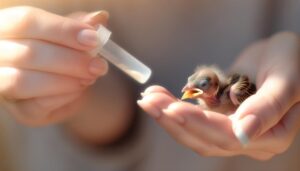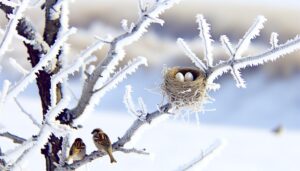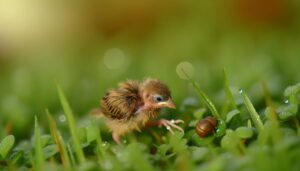7 Essential Steps to Care for an Injured Baby Sparrow
Start by gently examining the sparrow for injuries, looking for bleeding, broken bones, or swelling. Create a calm and soft-bedded space in a box with good ventilation.
Handle the bird carefully, speaking softly and minimizing movement. Keep the sparrow warm with a low-heating pad under half the box, allowing a cool side.
Hydrate by offering small drops of purified water frequently. Watch for unusual behavior and seek prompt veterinary care if needed.
If you want to gain a deeper understanding of sparrow care steps and best practices, there's more detail on specific actions and observations to explore.
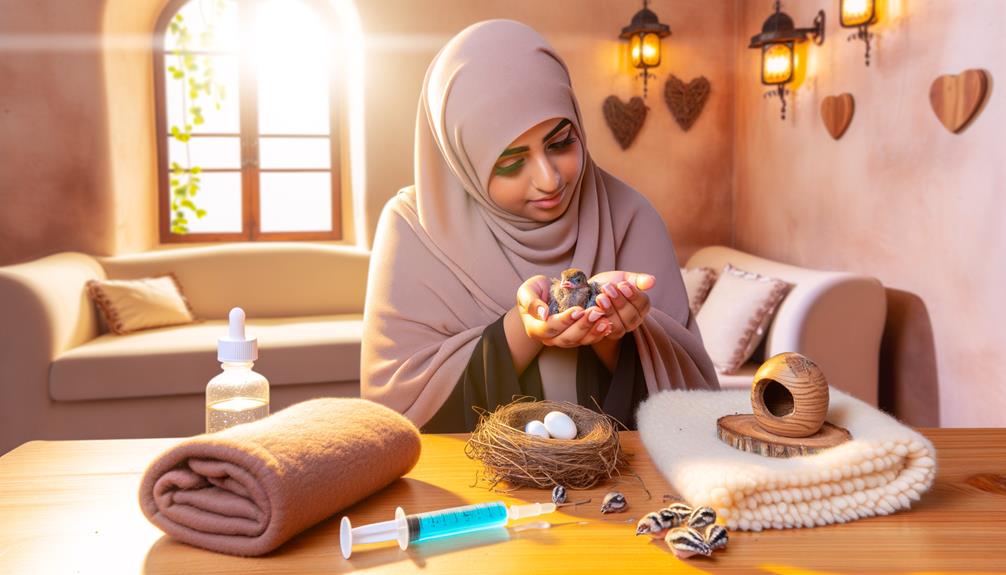
Key Takeaways
- Assess for injuries: Check for bleeding, fractures, and distress signs, and document observations for veterinary consultation.
- Create a safe space: Place the sparrow in a soft-bedded, ventilated box in a quiet, dimly-lit area.
- Handle with care: Gently scoop the sparrow with clean hands or a soft cloth and limit handling to reduce stress.
- Provide warmth: Use a low heating pad under half of the box and ensure a cool side for temperature regulation.
- Seek veterinary help: Contact a wildlife rehabilitator or avian vet if signs of labored breathing, persistent bleeding, or significant distress are observed.
Assess the Injury
Begin by carefully observing the baby sparrow to determine the extent and type of injury it has sustained. Gently approach the bird, ensuring you don't cause additional stress. Look for visible signs like bleeding, broken bones, or deformities. Check its wings and legs for any irregularities: drooping wings or an inability to move might indicate fractures. If the sparrow is breathing heavily or making distressed sounds, it's likely in pain or shock.
Next, using a small flashlight, inspect the bird's eyes and beak for any discharge or swelling. Note its behavior—lethargy or an inability to stand could signify internal injuries. Document your observations meticulously; this information will be vital when consulting a veterinarian or wildlife rehabilitator.
Prepare a Safe Space
To start, choose a calm location away from household traffic to minimize stress for the injured baby sparrow.
Next, line a small box with soft bedding such as tissues or a cloth to keep it comfortable and warm.
Make sure the box has ventilation holes to guarantee proper airflow.
Choose a Quiet Location
When caring for an injured baby sparrow, choose a quiet, dimly-lit area in your home to create a safe and stress-free environment. Select a room with minimal foot traffic and away from loud noises like televisions, radios, or busy household activities.
A calm environment helps reduce the baby's stress levels, promoting faster recovery. Make sure the space is free from potential hazards such as pets or curious children. Maintain a consistent temperature, avoiding drafts or direct sunlight that could harm the baby sparrow.
A small, closed-off area like a bathroom or a corner of a quiet room works well. Providing this serene setting is essential for the sparrow's healing, allowing you to focus on its care with compassion and precision.
Use a Soft Bedding
Establish a comfortable and safe nest for the injured baby sparrow by using soft, non-abrasive materials like tissues, paper towels, or clean cloth. Line a small box or container with these materials to provide cushioning and warmth. Confirm the bedding is clean and dry to prevent infections. Avoid using materials like cotton balls or loose threads, which can entangle the bird's tiny feet.
Place the nest in a quiet, draft-free area. Ensure the container has ventilation but is safe from predators and household pets. Changing the bedding daily helps maintain hygiene.
Handle With Care
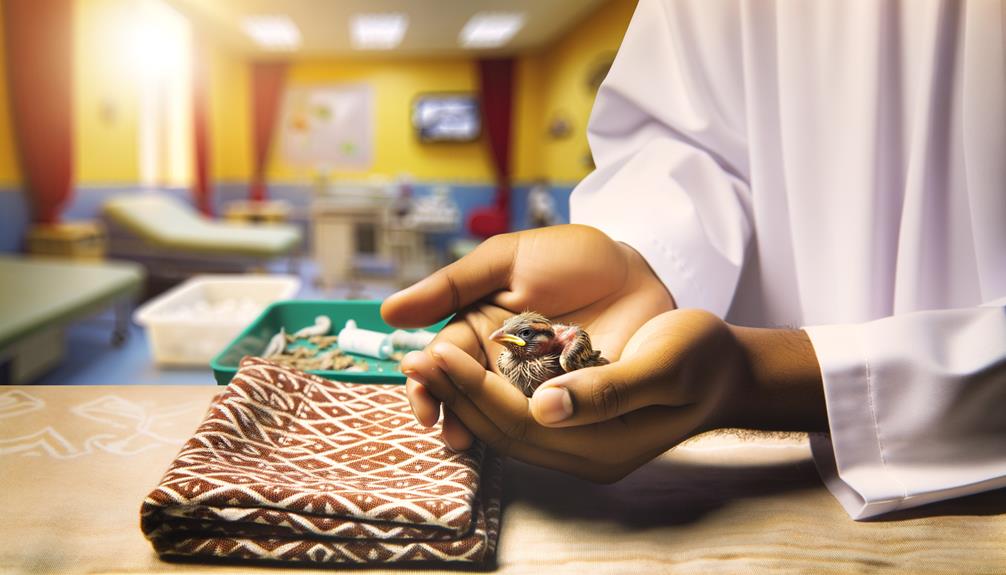
Handling a baby sparrow with utmost care is crucial to avoid causing further injury or stress. Gently scoop the sparrow using both hands to support its delicate body. Make sure your hands are clean and dry to prevent infection. Avoid squeezing; maintain a soft, secure hold.
If you need to move the sparrow, use a small, soft cloth or towel to lift it. Speak softly to minimize its fear. Avoid sudden movements that could startle the bird.
Limit handling time to reduce stress, and place the sparrow back in its nest or a safe, soft-bedded box as soon as possible. Remember, your gentle touch and calm demeanor can greatly impact the sparrow's recovery journey.
Keep the Sparrow Warm
To keep the injured baby sparrow warm, place a heating pad on the lowest setting under half of its container, ensuring it has a cool side to move to if needed.
Use soft, breathable bedding like tissue or cloth to provide comfort and insulation.
Monitor the temperature consistently to maintain a safe and steady warmth, essential for the sparrow's recovery.
Use a Heating Pad
Keeping the injured baby sparrow warm is vital, and a heating pad set on low can provide the necessary warmth without risking burns. Place the heating pad under half of the box or container, so the sparrow can move away if it gets too warm. Make sure the pad is wrapped in a towel to diffuse the heat and prevent direct contact. Check the temperature frequently, aiming for a cozy warmth, not hot.
Your watchfulness will help avoid overheating, which can be as harmful as cold. If you don't have a heating pad, a warm water bottle wrapped in cloth can serve as a temporary substitute. Keeping the environment at a stable, gentle warmth is crucial for the sparrow's recovery.
Provide Soft Bedding
Alongside maintaining warmth with a heating pad, providing soft bedding will guarantee the injured baby sparrow remains comfortable and secure. Choose materials that are gentle and non-irritating to their delicate skin. You'll need to create a cozy nest-like environment that mimics their natural habitat.
Here's how you can do it:
- Use soft, clean fabrics: Opt for materials like fleece or cotton, which are soft and won't snag their tiny claws.
- Layer appropriately: Add a few layers to provide cushioning and insulation.
- Avoid loose threads: Make sure the fabrics don't have frayed edges that could entangle the sparrow.
- Regularly clean bedding: Change the bedding daily to keep the environment hygienic and reduce stress.
This thoughtful approach secures their comfort and promotes healing.
Monitor Temperature Consistently
Consistently monitoring the temperature is crucial to make certain the injured baby sparrow remains warm and stable. Aim for a temperature around 95°F (35°C).
Use a small heat lamp or heating pad set on low, but always make certain a part of the enclosure is cooler so the sparrow can move away if it gets too warm.
Place a thermometer in the enclosure to check the temperature regularly. Adjust the heat source as needed to maintain the ideal warmth.
Be cautious of overheating, which can be as harmful as being too cold.
Your diligent care will provide the comforting environment the baby sparrow needs to recover. Remember, your attentiveness can make all the difference in its healing journey.
Hydration Needs
Ensuring a baby sparrow stays hydrated is vital, as even a short period without water can lead to serious health issues. You'll need to provide water carefully to avoid aspiration. Use a dropper or a small, clean paintbrush to offer small drops directly into the bird's beak.
Here are essential points to keep in mind:
- Frequency: Offer water every 20-30 minutes during daylight hours.
- Amount: Just a drop at a time to prevent choking.
- Cleanliness: Always use purified or boiled water cooled to room temperature.
- Signs of Dehydration: Watch for sunken eyes, lethargy, or wrinkled skin.
Feeding Guidelines
After confirming the baby sparrow is well-hydrated, you'll need to focus on providing proper nutrition to support its growth and recovery. Use a mix of high-protein foods, like soaked cat kibble, hard-boiled egg yolk, and mealworms.
Feed the sparrow every 20-30 minutes during daylight hours. Use a clean, small syringe or tweezers to gently place food into its mouth. Make sure the food is at room temperature to avoid shocking its system.
Monitor the sparrow's crop, located at the base of its neck, to make sure it's filling but not overly distended. Cleanliness is essential; always wash your hands and utensils before feeding.
Gradually introduce more solid foods as the sparrow becomes stronger and more active.
Monitor Behavior
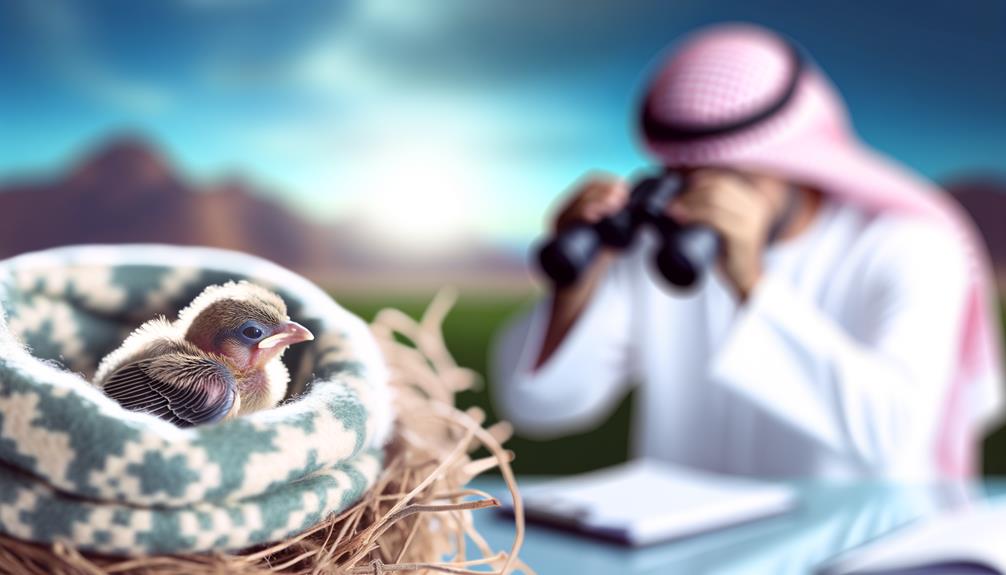
Keep a vigilant eye on the baby sparrow's behavior, as changes can indicate its health and recovery progress. Observe its activity level, alertness, and response to stimuli regularly. Healthy behavior signs include active movement, consistent chirping, and a steady appetite. Any deviation from these can signal distress or worsening health.
Activity Level:
Is it moving around or remaining lethargic?
Appetite:
Is it eating regularly, or showing disinterest in food?
Alertness:
Are its eyes bright and open, or dull and closed?
Response to Stimuli:
Does it react to your presence or remain unresponsive?
Seek Veterinary Help
If you notice any concerning changes in the baby sparrow's behavior, it's time to seek veterinary help immediately. Look for signs like labored breathing, persistent bleeding, or unresponsiveness. Contact a wildlife rehabilitator or avian veterinarian quickly.
When transporting the sparrow, place it in a small, ventilated box lined with a soft cloth to avoid further injury. Keep the box in a quiet, warm location during transit. Be prepared to describe the sparrow's condition and any symptoms you've observed.
Veterinary professionals have the expertise to provide the necessary care, increasing the chances of recovery. Remember, prompt action can make a vital difference in the bird's survival and well-being. Your compassion and diligence are essential in these critical moments.
Administer First Aid
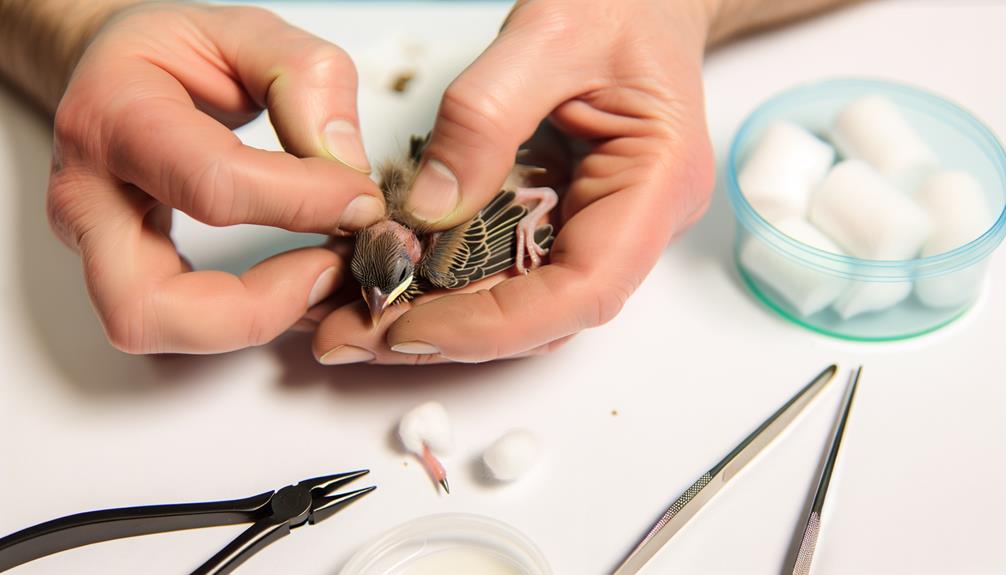
Gently assess the baby sparrow for visible injuries, such as cuts or broken limbs, to determine the immediate first aid required. Carefully clean any cuts with a saline solution. Apply a small amount of antibiotic ointment to prevent infection.
If you suspect a broken limb, create a temporary splint using soft materials.
Cleaning Cuts:
Use a saline solution to gently clean any wounds.
Antibiotic Ointment:
Apply a small amount to cuts to fend off infection.
Splinting Broken Limbs:
Use soft materials like gauze to create a temporary splint.
Hydration:
Offer a few drops of sugar water to keep the sparrow hydrated.
Plan for Release
Before releasing the baby sparrow, make certain it can fly confidently and forage for food independently. Observe its ability to navigate different perches and respond to natural stimuli.
Gradually introduce it to an outdoor aviary or a safe, enclosed garden area to acclimate it to the environment.
Choose a calm, clear day for the release. Early mornings are ideal as they provide ample daylight for the sparrow to explore and find shelter. Make sure there's access to water and natural food sources nearby. Stay vigilant and ready to intervene if the sparrow struggles initially.
Release it near other sparrows if possible, as they can integrate it into their social structure. Your attentive care ensures its successful adjustment back to the wild.
Conclusion
You've done a wonderful job by watching, waiting, and working with wisdom. With a safe space, careful handling, and consistent warmth, you've created a sanctuary for the sparrow.
By hydrating and helping, you've offered hope. Keep monitoring its movements and, if needed, consult a vet. Your compassionate care can culminate in a successful release.
Remember, every small step in nurture leads to nature's return, where the sparrow can soar and sing again.

